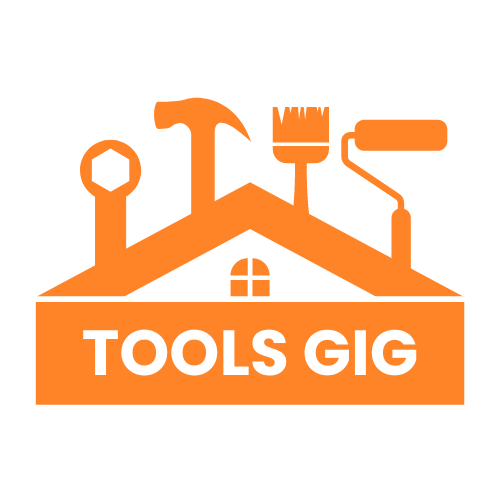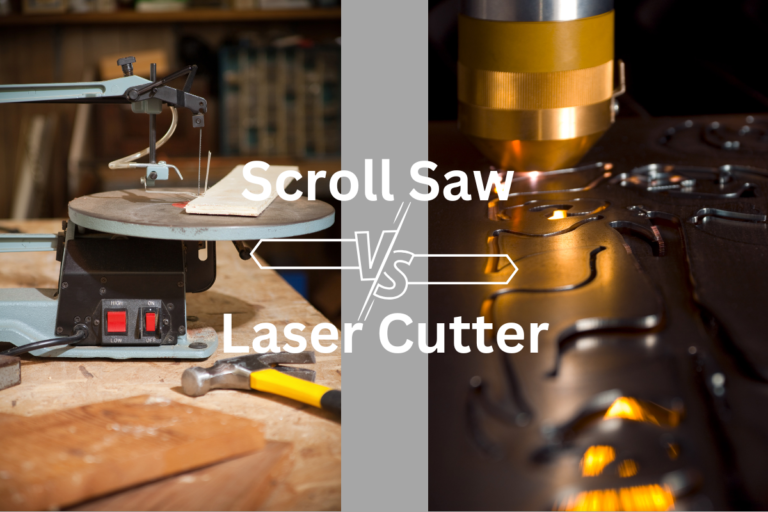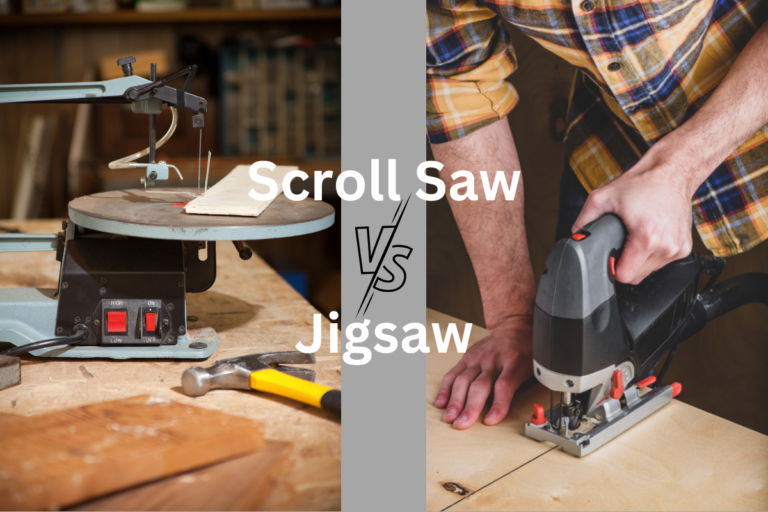What Scroll Saw Blade Should I Use? [Size, Shape, Tooth & More…]
As an Amazon Associate I earn from qualifying purchases.
A scroll saw blade comes in various sizes, shapes, and tooth configurations. Depending on the working purpose you can select which scroll saw blade to use. Also, all those blades have their advantages and disadvantages.
No matter you’re a pro or a newbie if you have enough blade options or you want to buy then you can choose depending on the wood size (thin or thick), wood surface (soft or hard), and the cutting quality (fine or fast). Otherwise, you need to go with a specific blade category.
If you have a thin or softwood, you should use smaller numbers and higher teeth blades; for thicker or hardwood, you should use higher numbers and fewer teeth blades.
Let’s see more about which prospective “What Scroll Saw Blade Should I Use?”
Contents
Which Scroll Saw Blade to Use?
You can use any scroll saw blade on any wood, but that could damage the wood and the design you want to create on the wood. Also, you won’t get the delicate cut you have dreamed of. So, look at the three terms or points (size, teeth, and shape) to select the perfect Scroll saw blade for your project.
Size:
The first thing you should consider is the size. For example, a scroll saw blade size typically could be #2/0 to #12. A blade size determines how comfortably you can cut a thin or thick wood or board. I chose six commonly used blades; these are 2, 3, 5, 7, 9, and 12.
The number 2 scroll saw blade is 0.029 inches wide and 0.012 inches thick, which easily helps to cut and design material like 1/4 inch or less thick wood or board.
The number 3 scroll saw blade is 0.032 inches wide and 0.014 inches thick for material like 1/2 inch or less thick wood.
Note: Number 2 and 3 scroll saw blade is best for clean cuts, fast cutting, true tracking, and no burning.
The number 5 scroll saw blade is 0.038 wide and 0.016 inches thick helps to cut and design material like 3/4 inch or less thick softwood.
The number 7 scroll saw blade is 0.045 inches wide and 0.017 inches thick for material like 3/4 inch to 1.5-inch thick hardwood and boards.
The number 9 scroll saw blade is 0.053 inches wide and 0.018 inches thick. This size blade is a little more robust for material 1.5 to 2.5inch thick hardwoods.
The number 12 scroll saw blade is 0.062 inches wide and 0.024 inches thick for more thick material to have a straight line or straight cut.
So, the conclusion is that fewer number blades give you more control when you cut thin wood to make puzzle cuts or various curve designs. Another hand, the higher number of blades gives you the freedom to cut fast and straighter cut.
Note: All these Scroll saw number blades have both flat and skip teeth blades.
Tooths: Teeth Per Inch (TPI)
![What Scroll Saw Blade Should I Use? [Size, Shape, Tooth & More...] 2 blades](https://toolsgig.com/wp-content/uploads/2022/12/blades.jpg)
The second thing is teeth per inch (TPI). If your blade has more teeth per inch, it will provide a smoother and finer finish on thinner wood. But having more teeth per inch makes it hard to cut thicker or hardwoods and more difficult to evacuate the chips coming out of the wood or board.
On the other hand, if your blade has fewer teeth per inch, it will be better for the thicker or hardwoods rather than cutting thinner and softwoods.
Of the six common blades I have chosen from them, the number 2 and 3 scroll saw blade has more teeth per inch than other number blades, whereas the number 2 and 3 come with 20 and 18.5 TPI. These two blades are for thinner and soft woods or boards to provide a smoother and finer finish.
The number 5 and 7 scroll saw blade comes with 12.5 and 11.5 teeth per inch. These two blades provide a smoother and finer finish for medium thicker and medium hardwoods or boards.
The larger number 9 and 12 scroll saw blade comes with 11.5 and 9.5 teeth per inch. These two blades provide a smoother and finer finish for thicker hardwood or boards.
So, the conclusion is that more teeth mean a smoother cut on thin wood, and fewer teeth mean a smoother cut on thick wood.
Shape
There are different shapes of blades available in the market. I have chosen five tooth blades from them that will cover almost all your projects.
Regular tooth blade
Regular or flat blades come with straight-faced teeth. Their teeth are pointed downwards, and as the saw blade travels downward, it cuts the wood straight and fine.
Reverse tooth blade
![What Scroll Saw Blade Should I Use? [Size, Shape, Tooth & More...] 3 Reverse Tooth Scroll Saw Blade](https://toolsgig.com/wp-content/uploads/2022/12/Scroll-Saw-Blade-Reverse-Tooth.jpg)
Reverse blades are the combination of double teeth and skipped teeth. So there, you will see they skip one tooth rather than having it next to the previous one, and half of the upper teeth faced downward, and the other half faced upwards. So that every time you get a clean and fine cut. But they leave scorch or burn marks in tight areas.
Skipped tooth blade
Skipped blades are the spacing of the teeth. They skip one tooth rather than having it next to the previous one to help the blade cut faster through coats and very thin surfaces.
You will get another version of it which is skipped by reverse tooth blades. It is almost the same as the skipped teeth blade, but the teeth structure follows reverse teeth blades to have clean and finer cuts.
Crown tooth blade
Crown blades are the structure where you see two teeth facing each other. They cut quickly both up and down stroke, but the finish could be better and more satisfactory. The main thing is that they are good for sanding heavily.
Spiral tooth blade
Spiral blades are twisted around the structure so that the teeth point in every direction and while upstroke and downstroke or forward and backward, you don’t need to rotate the board; slide the board in any direction to get a 360º fine finish.
So, the conclusion is that for the finer cut, you can use regular or spiral tooth blades and for the faster cut, you can use skipped and crown tooth blades.
Frequently Asked Questions
Q. How often should I change my Scroll saw blade?
Ans: Changing the Scroll saw blade depends on your usage. On continuous use with little maintenance, a premium quality scroll saw blade lasts about 12 to 120 hours, whereas a cheap scroll saw blade lasts about 30 to 45 minutes.
After this time, you should change the blade to have burn free, delicate, and fast cut.
Also, you have to keep in mind that if you use hardwood or thick wood, the blade’s lifespan will reduce fast. Also, operating the blade at high-speed and having the tension too tight or loose reduces the blade’s lifespan.
Q. Why do my scroll saw blades keep breaking?
Ans: A blade can keep breaking for two reasons. First, it could be for selecting hardwood or thick wood for small blades or curve cutting on large blades, and the second reason is using too much loose tension or tight tension.
Q. Why does my wood bounce on the scroll saw?
Ans: The main reason for wood bouncing is using a large number of Scroll saw blades on thin wood and the speed at which you are cutting. If you are cutting hardwood at a slow speed, it will bounce the wood. So, use the Scroll saw at the speed the project requires and keep the tight pressure on the wood with your hand.
Q. Is A Scroll Saw Worth It?
Scroll saw is a perfect tool for detailed woodworking, and the advantages that make you feel yes, a scroll saw is worth it. Here is a detailed article that you can read it. Does A Scroll Saw Really Worth It?
Final Word
Consider the Scroll saw blade size, tooth, and shape for your selected wood project. This will help you select scroll saw blades for thinner and thicker wood to make your work easier. Also, I have described the most common size, tooth, and shape of the blades you need for almost all of your projects.
I hope you got all the points and selected a delicate blade for your project. Thank you.

![What Scroll Saw Blade Should I Use? [Size, Shape, Tooth & More...] 1 Which Scroll Saw Blade to Use](https://toolsgig.com/wp-content/uploads/2022/12/Which-Scroll-Saw-Blade-to-Use.jpg)



One Comment